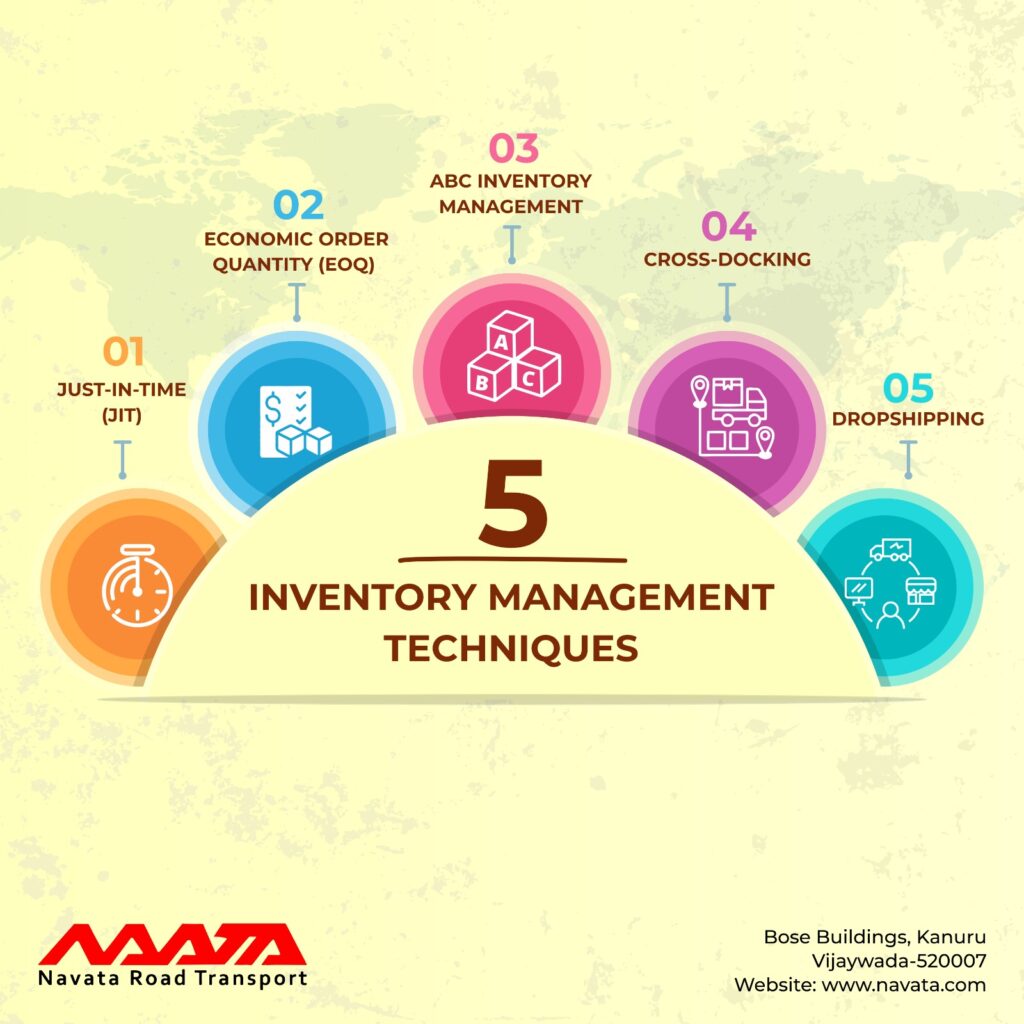Inventory Management Techniques: 5 Effective Methods
Table of Contents
Inventory Management Techniques
The administration of finished items that are prepared for sale as well as the tracking and control of inventory orders, their use, and storage are all made possible by inventory management techniques.
Because of this, it’s crucial for a company to manage its inbound and outbound inventory in order to minimize losses and increase revenues. This is where inventory management techniques come into play.
Also Read: 7 Important Objectives of Inventory Management System
Small businesses frequently experience cash flow problems, which can have an impact on stock levels and result in stockouts and disgruntled consumers. If there is too much of this, the firm may fail. inventory management techniques come in handy in this situation.
A corporation will employ a variety of inventory management techniques depending on the kind of business or product being examined. Some of these managerial techniques are:

Just-in-time (JIT) Inventory Management
Just-In-Time (JIT) inventory management is a methodology employed by businesses to optimize their inventory levels by receiving and producing goods only when they are needed in the production process or to fulfill customer orders. The primary objective of JIT is to minimize waste, reduce carrying costs, and improve operational efficiency.
The core principle of Just-in-time Method revolves around eliminating or reducing excess inventory in the supply chain. Instead of stockpiling large quantities of inventory, JIT focuses on maintaining lean inventory levels by synchronizing production with demand. This approach requires close coordination and communication between suppliers, manufacturers, and customers.
Key Features of Just-In-Time Inventory Management
Demand-driven Production
JIT operates based on the actual demand from customers. Production activities are triggered when an order is received, ensuring that goods are produced precisely when they are needed.
Continuous Flow
JIT aims to achieve a smooth and uninterrupted flow of materials, components, and finished products throughout the supply chain. This requires close collaboration between suppliers and manufacturers to ensure that materials arrive in a timely manner.
Reduced Lead Times
JIT places a strong emphasis on minimizing lead times in the supply chain. Shorter lead times enable businesses to respond quickly to changes in customer demand and reduce the need for excessive inventory.
Reliable supplier partnerships: JIT relies on strong relationships with suppliers to ensure timely delivery of materials and components. Suppliers must be reliable and capable of meeting delivery deadlines to avoid disruptions in the production process.
Quality Control
JIT places significant importance on quality control to minimize defects and rework. By focusing on quality at every stage of the production process, JIT aims to eliminate waste caused by faulty or defective products.
Benefits of Just-In-Time Inventory Management
Cost Reduction
JIT helps businesses reduce carrying costs associated with excess inventory, such as storage, insurance, and handling expenses. It also minimizes the risk of inventory obsolescence.
Increased Efficiency
By synchronizing production with demand, JIT eliminates bottlenecks and reduces idle time, leading to improved operational efficiency and resource utilization.
Improved Customer Satisfaction
JIT enables businesses to respond quickly to customer demands, ensuring timely delivery of products. This leads to higher customer satisfaction and loyalty.
Waste Reduction
JIT aims to eliminate waste in the production process, including excess inventory, overproduction, transportation, waiting times, and defects. This lean approach improves overall process efficiency and productivity.
Flexibility and Adaptability
JIT allows businesses to be more agile and responsive to changes in the market. It facilitates quick adjustments to production levels, product mix, and customer requirements.

Economic Order Quantity (EOQ) Inventory Management
Economic Order Quantity (EOQ) is an inventory management technique used to determine the optimal order quantity that minimizes the total cost of ordering and holding inventory. EOQ takes into account the trade-off between the costs of ordering (such as setup costs) and the costs of holding inventory (such as storage and carrying costs).
EOQ Technique is Based on Several Assumptions
Demand is Known and Constant
EOQ assumes that the demand for a product is consistent and can be accurately forecasted over a given period. This assumption allows for a reliable estimation of the optimal order quantity.
Lead Time is Constant
EOQ assumes that the lead time, which is the time between placing an order and receiving it, remains constant. This assumption helps in determining when to place the next order.
Costs are Known and Stable
EOQ assumes that costs associated with ordering and holding inventory, such as setup costs and holding costs, are known and do not fluctuate during the analysis period.
Benefits of EOQ Technique
Cost Optimization
By balancing ordering and holding expenses, EOQ helps to reduce the total cost of inventory management. It guarantees that inventory levels are not too high, resulting in expensive carrying costs, nor too low, resulting in frequent orders with high setup costs.
Inventory Control
EOQ provides a systematic approach to managing inventory levels. By calculating the optimal order quantity, businesses can maintain adequate stock levels to meet customer demand without tying up excessive capital in inventory.
Efficient Production Planning
EOQ enables businesses to plan their production schedules based on the optimal order quantity. This helps in aligning production activities with inventory replenishment, ensuring a smooth flow of goods and minimizing disruptions.
Improved Customer Service
By effectively managing inventory levels, EOQ helps ensure product availability, reducing the risk of stockouts and enhancing customer satisfaction.

You Might Also Like To Read: 8 Best Inventory Management Software For Logistics
ABC Inventory Management
ABC inventory management, also known as ABC analysis, is a method used in inventory management to categorize items based on their value and prioritize them accordingly. It helps businesses identify the most critical items and allocate resources effectively to optimize inventory control.
The ABC Analysis Categorizes Inventory Items Into Three Groups
A-Items (High-Value Items)
A-Items represent the most valuable and critical items in terms of their contribution to overall revenue or cost. They typically account for a relatively small percentage of the total inventory items but contribute a significant portion of the total inventory value. These items require close monitoring, precise control, and frequent replenishment to prevent stockouts and ensure customer satisfaction.
Examples of A-Items may include high-demand products, expensive components, or fast-moving items.
B-Items (Moderate-Value Items)
B-Items have a moderate value and contribute moderately to the total inventory value. They are less critical than A-Items but still require effective management to ensure availability and customer service. B-Items generally require periodic review and replenishment.
Examples of B-Items may include products with moderate demand, mid-priced components, or items with a relatively stable market.
C-Items (Low-Value Items)
C-Items have a lower value and contribute a smaller portion to the total inventory value. They are typically more abundant in quantity but have a lower individual value. C-Items are less critical and may have less frequent demand or longer lead times. While C-Items do not require intense monitoring, they still need proper management to avoid excess stocking and obsolescence.
Examples of C-Items may include low-demand products, inexpensive components, or slow-moving items.
Benefits of ABC Inventory Management
Efficient Resource Allocation
By categorizing items based on their value, businesses can allocate their resources, such as time and attention, more effectively to the most critical inventory items.
Enhanced Inventory Control
Prioritizing A-Items ensures that businesses can maintain adequate stock levels of high-value items, reducing the risk of stockouts and potential revenue loss.
Cost Optimization
ABC analysis helps identify opportunities to optimize inventory costs. It allows businesses to focus on reducing carrying costs for low-value items and preventing excess stocking for items with low demand.
Streamlined Operations
ABC analysis enables businesses to streamline their inventory management processes by tailoring control measures and replenishment strategies based on the categorization of items.

You Might Also Like To Read: 15 Inventory Management Techniques You Need to Use Today
Cross-Docking
Cross-docking is an inventory management technique that involves the direct transfer of goods from inbound to outbound transportation without the need for long-term storage or warehousing. It aims to streamline the supply chain by minimizing inventory holding costs, reducing order cycle times, and improving overall operational efficiency.
The Process Typically Involves The Following Steps
Inbound Receiving
Products arrive at a cross-docking facility, where they are quickly unloaded and sorted based on their destination. The focus is on efficient handling and rapid transfer of goods rather than long-term storage.
Sorting and Consolidation
Similar products or items with the same destination are grouped together. This consolidation helps optimize transportation by reducing the number of delivery vehicles needed.
Outbound Shipment Preparation
Once the products are sorted and consolidated, they are loaded directly onto outbound transportation, such as trucks or trailers. This step ensures that goods can be dispatched to their final destinations promptly.
Benefits of Cross-Docking Inventory Management
Reduced Inventory Holding Costs
Cross-docking eliminates the need for long-term storage, thereby minimizing costs associated with warehousing, storage space, and inventory holding. This cost reduction can significantly impact a company’s bottom line.
Faster Order Fulfillment
By bypassing the storage process, cross-docking allows for faster order processing and shorter order cycle times. This efficiency helps meet customer demands quickly, leading to improved customer satisfaction.
Lower Transportation Costs
Cross-docking optimizes transportation by consolidating products and reducing the number of individual deliveries. This consolidation maximizes truckload capacity, reduces transportation costs, and minimizes carbon emissions.
Enhanced Supply Chain Efficiency
The streamlined nature of cross-docking eliminates unnecessary handling, storage, and picking processes. It improves the overall efficiency of the supply chain by reducing lead times and improving order accuracy.
Flexibility and Agility
Cross-docking provides businesses with flexibility in adapting to changes in demand, product mix, and market conditions. It enables rapid response to fluctuations in customer requirements and reduces the risk of excess or obsolete inventory.
Dropshipping Inventory Management
Dropshipping is an inventory management strategy in which the merchant does not keep physical inventory and instead depends on suppliers or wholesalers to fill client orders. When a customer puts an order, the retailer sends the order information to the supplier, who ships the product straight to the client. Dropshipping has grown in popularity due to its minimal initial investment, lower inventory risk, and streamlined logistics.
Key Factors of Dropshipping Inventory Management
Supplier Selection
Choosing reliable suppliers is vital in dropshipping. Retailers should assess suppliers based on product quality, shipping times, pricing, and ability to handle order volume. Working with reputable suppliers ensures a smooth fulfillment process and enhances customer satisfaction.
Product Catalog Management
Retailers must curate a product catalog that is relevant to their target market. It is critical to analyze and adjust product offers on a frequent basis based on demand, trends, and client feedback. Suppliers should give accurate and complete product information to ensure a seamless shopping experience for customers, including descriptions, photos, and specs.
Inventory Monitoring and Replenishment
While retailers do not physically hold inventory, they must track supplier inventory levels to ensure product availability. Real-time inventory monitoring systems or regular communication with suppliers can help identify low-stock situations and initiate timely reorders. Effective communication and coordination with suppliers are critical to avoiding stockouts and backorders.
Order Processing and Tracking
Efficient order processing is essential for a smooth drop shipping operation. Retailers should establish streamlined systems to receive customer orders, forward them to suppliers promptly, and provide order tracking information to customers. Automated order processing tools or integration with suppliers’ systems can enhance efficiency and minimize errors.
Customer Service and Returns Management
Despite not physically handling the products, retailers are responsible for providing excellent customer service. This includes promptly addressing customer inquiries, resolving issues related to orders or shipments, and handling returns or exchanges. Clear communication channels with suppliers and establishing return policies and procedures are vital to manage customer expectations effectively.
Benefits of Dropshipping Inventory Management
Low Upfront Costs
Dropshipping eliminates the need for significant upfront investments in inventory, warehousing, and fulfillment infrastructure, making it an attractive option for aspiring entrepreneurs.
Reduced Inventory Risk
With drop shipping, retailers only purchase products after receiving customer orders. This minimizes the risk of holding excess inventory, reduces the costs associated with carrying inventory, and avoids inventory obsolescence.
Scalability and Flexibility
Dropshipping allows businesses to scale operations quickly as they are not limited by physical inventory constraints. It enables retailers to add or remove products easily, expand into new markets, and test different product offerings with minimal risk.
Expanded Product Range
Dropshipping allows you to access a wide variety of products without having to manage inventory. Retailers can offer a large range of products, appealing to a wide range of customer preferences and enhancing sales potential.
Thanks For Reading: Understanding Inventory Management Techniques: 6 Effective Methods
Powered By 360Presence




